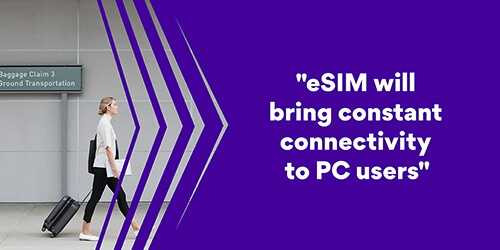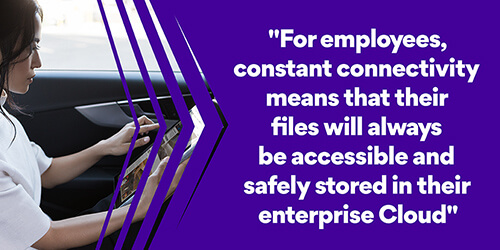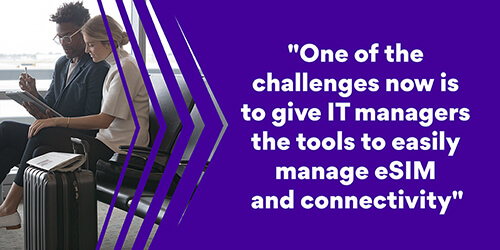Protecting subscriber privacy and 5G IoT with tamper-proof secure elements

The era of the eSIM is upon us and it’s transforming the way we connect, work and travel. We sat down with Microsoft and IDEMIA experts, Shai Guday and Emir Aboulhosn to discuss the collaboration between the two companies and how it will fuel the rise of eSIM connectivity.
 Shai Guday (Microsoft): Experiences normally enjoyed on a smartphone can now be achieved on PCs with all-day battery life. Along with the prevalence of smartphones in the last few years, the shift to Cloud storage and services, created a demand for constant connectivity. Since we announced Windows 10 support for eSIM back in 2016, we’ve seen much more interest and support for cellular-enabled devices, not only from PC makers, but also from the hardware vendors who create modems that now support eSIMs.
Shai Guday (Microsoft): Experiences normally enjoyed on a smartphone can now be achieved on PCs with all-day battery life. Along with the prevalence of smartphones in the last few years, the shift to Cloud storage and services, created a demand for constant connectivity. Since we announced Windows 10 support for eSIM back in 2016, we’ve seen much more interest and support for cellular-enabled devices, not only from PC makers, but also from the hardware vendors who create modems that now support eSIMs.
Emir Aboulhosn (IDEMIA): With eSIM we will bring this constant connectivity to PC users. On top of it we will also enhance security. PC users will no longer need to connect to unsecured, public Wi-Fi – from an IT manager perspective this is the icing on the cake.
E.A.: In the smartphone market, we anticipate all major manufacturers will include eSIM in their flagship lineup within 24 months. In the wearables market, operators are also preparing for the growth of eSIM-enabled devices.
S.G.: Besides constant connectivity and improved security, one clear benefit to the Enterprise market is to simplify the enforcement of data usage rules set by each company. And with IDEMIA’s multi-MNO support, companies can now create multiple SIM profiles for their employees, allowing them to have connectivity no matter which country they’re working from. They are in total control of the connectivity and can for instance remotely wipe the SIM profile on the eUICC** if the device is ever stolen.
 E.A: For employees, constant connectivity means that their files will always be accessible and safely stored in their enterprise Cloud. This gives them the freedom to work anywhere. From the perspective of an IT manager, their role will be streamlined. They’ll be able to activate and manage the connectivity of all employee devices from one single point. They can now focus on managing the connectivity of the devices rather than having to learn different portals for different MNOs, or procuring and physically distributing physical SIM cards to each employee.
E.A: For employees, constant connectivity means that their files will always be accessible and safely stored in their enterprise Cloud. This gives them the freedom to work anywhere. From the perspective of an IT manager, their role will be streamlined. They’ll be able to activate and manage the connectivity of all employee devices from one single point. They can now focus on managing the connectivity of the devices rather than having to learn different portals for different MNOs, or procuring and physically distributing physical SIM cards to each employee.
S.G. The biggest challenge is getting this new ecosystem to a level of maturity. OEMs will truly accelerate the production of eSIM-enabled PC as soon as they will see more general demand, and their market potential is dependent on MNOs that will actually deploy eSIM systems to support these devices. Another challenge is to adapt the standards to PC usage. The eSIM standards for consumer devices have originally been defined from the perspective of smartphones and the UX paradigm does not always translate well to a PC.
 E.A.: The PC is incredibly more powerful when it is always connected. Microsoft has done an amazing job of building the use case of the always-connected PC and putting eSIM support into the Windows OS and an Office 365 experience. One of the challenges now is to give IT managers the tools to easily manage eSIM and connectivity throughout their enterprise. Our collaboration with Microsoft is about enabling IT managers to use their Mobile Device Management systems (MDM) to digitally set-up employees’ devices and connectivity. With our solution, we are integrating MDM systems with the eSIM provisioning systems of multiple mobile operators. Creating this bridge with MDM vendors means we are providing quick access to the enterprise eSIM market for our mobile operators customers. Our agnostic solution allows everyone, to accelerate the adoption of eSIM since it benefits the entire telecom industry.
E.A.: The PC is incredibly more powerful when it is always connected. Microsoft has done an amazing job of building the use case of the always-connected PC and putting eSIM support into the Windows OS and an Office 365 experience. One of the challenges now is to give IT managers the tools to easily manage eSIM and connectivity throughout their enterprise. Our collaboration with Microsoft is about enabling IT managers to use their Mobile Device Management systems (MDM) to digitally set-up employees’ devices and connectivity. With our solution, we are integrating MDM systems with the eSIM provisioning systems of multiple mobile operators. Creating this bridge with MDM vendors means we are providing quick access to the enterprise eSIM market for our mobile operators customers. Our agnostic solution allows everyone, to accelerate the adoption of eSIM since it benefits the entire telecom industry.
S.G.: 5G will be a major focal point in the ecosystem. It will bring massive IoT and the paradigm will shift to enable that increased scale. MNOs investing in 5G are looking to onboard as many devices as possible on their network. We’re going to rely on eSIMs to deliver seamless capabilities into the market. There is tremendous opportunity ahead.
E.A.: Indeed, 5G is not only about greater speed, but also greater network capacity and connecting a wider range of devices. 5G lower latency and higher bandwidth also means that all of these connected devices will be sending real-time data up into the Cloud, and enterprise employees can use that data for critical business decisions or processes. eSIM will be the centerpiece for cellular connectivity to becomes ubiquitous. Working with Microsoft and with OEMs, IDEMIA will provide the critical elements to support MNOs’ eSIM initiatives.
*Original Equipment Manufacturers
** Embedded UICC: the secure element used to provision and secure eSIM profile in the device